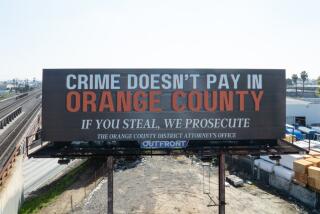Youths Smoke Out Truth in Advertising
- Share via
An anti-tobacco program for Orange County youth operates on the principle that the best defense is a good offense, by having kids design the don’t-smoke ads themselves.
This is more than an exercise in poster-making. The designs result in campus murals, professional billboards and TV public-service announcements.
The “Tune Out Tobacco” program is run by the county Health Care Agency and funded by Proposition 99, the 50-cents-a-pack cigarette tax passed by California voters in 1998.
Health educators visit about a dozen schools each year to talk to students not only about the dangers of smoking, but how advertising can be used to manipulate them into acting a certain way.
The students learn to analyze the advertisements of cigarette companies, said Andrea Miner, a health educator for the program, which is now in its second year. Miner tells the kids that ads prey on their insecurities. Beautiful, slim models suggest that smoking will make girls attractive, she says, while the Marlboro Man implies that a guy who smokes will be popular and cool.
Miner said she then points out the contradictions. The ads show healthy, athletic people, she tells the youngsters, while smoking makes people just the opposite.
The teenagers become angry at the thought that advertising can manipulate them into acting a certain way, Miner said. “No one wants to admit being manipulated,” she said.
That prepares them for the second phase of the program: Artist Michael Howard helps the youngsters come up with their own ad designs--this time against tobacco.
If the school is interested, the designs result in a mural on campus; 12 have been created so far. Otherwise, the designs are entered in a billboard contest.
The first billboard was recently erected on State College Boulevard in Anaheim. It depicts a large cartoon-cigarette holding a person and reads: “Who’s Smoking Who?” Another billboard is scheduled to go up this year.
Despite various anti-smoking campaigns, teen smoking has continued to rise. A survey from the University of Michigan shows that 34.6% of all high school seniors smoked in 1999, compared with 27.8% in 1992.
Studies show that advertising directly induces kids to smoke, says Michael Siegel, associate professor in social and behavior sciences at Boston University School of Public Health. “The tobacco companies have engaged in a persistent pattern of advertising to underage youth for nearly a decade,” Siegel said.
Tobacco industry representatives, however, took exception to accusations that cigarette companies target teenagers with their advertising.
R.J. Reynolds Tobacco Co. spokesman John Singleton said that the cigarette ads aren’t intended for children or teens, but directed toward adults who have chosen to smoke.
“We don’t even have models in cigarette ads if they don’t appear 25 or older,” Singleton said. “Other people may have a different view, but our advertising is directed at adults.”
In addition, he said, the tobacco company sponsors two programs that try to curb youth smoking, including “Right Decisions, Right Now,” which provides anti-smoking materials to middle schools.
In a classroom at Westminster’s Warner Intermediate School, students recently crafted anti-tobacco slogans and cartoons. “Don’t smoke, it’s not a joke,” wrote Trisha Ortiz, 13. “Tobacco people just think of themselves,” she said.
The drawings and slogans from Warner will be entered in a countywide contest, with the winning entry turned into a billboard. Other student groups in Orange County are designing and painting murals or developing radio and TV public-service announcements.
Though studies show that anti-smoking education by itself is generally ineffective with teenagers, Colleen Maxwell, teacher of the Warner students, said she’s grateful for the new county campaign. Designing the anti-tobacco ads helps students commit to not smoking, she said: “This is an action that lets them be part of the nonsmoking world.”
More to Read
Sign up for Essential California
The most important California stories and recommendations in your inbox every morning.
You may occasionally receive promotional content from the Los Angeles Times.










